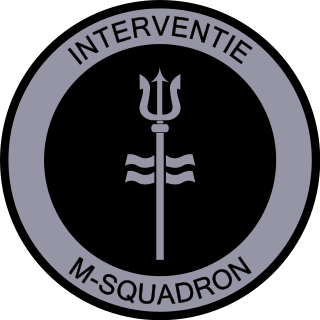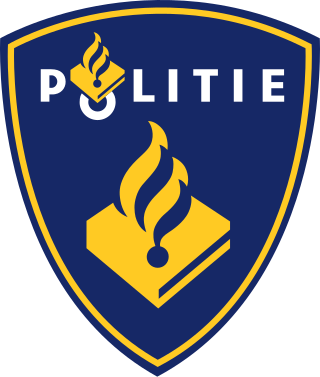
The Royal Netherlands Marine Corps is the elite naval infantry corps of the Royal Netherlands Navy, one of the four Armed Forces of the Kingdom of the Netherlands. The marines trace their origins to the establishment of the Regiment de Marine on 10 December 1665, by the then grand pensionary of the Dutch Republic, Johan de Witt and famous Admiral Michiel de Ruyter. It is the second-oldest still-active marine corps in the world.

The GIGN is the elite police tactical unit of the French National Gendarmerie. Among its missions are counterterrorism, hostage rescue, surveillance of national threats, protection of government officials, critical site protection, and targeting organized crime.

M-Squadron, formerly the Unit Interventie Mariniers, and before that known as the Bijzondere Bijstandseenheid, is an elite Dutch special forces unit which is tasked with conducting domestic counter-terrorist operations. M-Squadron is part of the Netherlands Maritime Special Operations Forces of the Netherlands Marine Corps.

The Royal Marechaussee also translated as the Royal Military Constabulary, is the national gendarmerie force of the Netherlands, performing military and civilian police duties. It is also one of the two national police forces in the Netherlands, alongside the National Police Corps, and is one of the four branches of the Netherlands Armed Forces.

The Special Duties Unit, nicknamed the "Flying Tigers", is the elite tactical unit of the Hong Kong Police Force tasked with countering terrorist attacks, hostage rescue, underwater search and recovery, and tackling serious crime involving firearms.

The Gruppo di Intervento Speciale (GIS) is the special forces unit of the Carabinieri. The Carabinieri, a branch of the Italian Armed Forces responsible for both military and civil policing, formed GIS in 1978 as a police tactical unit. In 2004, GIS assumed a special operations role, evolving to a special forces unit, in addition to the police tactical unit role, becoming part of the Comando interforze per le Operazioni delle Forze Speciali.

The Special Task Force (STF) is the premier police tactical unit of the South African Police Service (SAPS). The Special Task Force handles high risk operations that fall beyond the scope of classic policing which require specialised skills.

The Directorate of special units (DSU) is the police tactical unit of the Belgian Federal Police. In total, DSU consists of about 500 highly trained police officers. The centralized 50 operator small assault team of the intervention unit of the DSU is deployed in cases of terrorism, kidnappings, hostage taking and other forms of serious crime. DSU performs emergency responses, high-risk arrests and searches, observation operations, undercover operations and more.

The Brigade Speciale Beveiligingsopdrachten (BSB) is the elite police tactical unit of the Royal Netherlands Marechaussee. Its missions include counter-terrorism, protection of government and military officials, and targeting organised crime.

The Korps landelijke politiediensten was the national police force in the Netherlands from 1993 until January 2013, responsible for specialist missions that benefited from a centralized approach.

The Mobile Brigade Corps abbreviated Brimob is the special operations, paramilitary, and tactical unit of the Indonesian National Police (Polri). It is one of the oldest existing units within Polri. Some of its main duties are counter-terrorism, riot control, high-risk law enforcement where the use of firearms are present, search and rescue, hostage rescue, and bomb disposal operations. The Mobile Brigade Corps is a large component of the Indonesian National Police trained for counter-separatist and counter-insurgency duties, often in conjunction with military operations.

Following the September 11 attacks in 2001, several countries began military operations against Al-Qaeda and the Taliban during Operation Enduring Freedom (OEF) in Afghanistan. After the initial bombing operations, Operation Crescent Wind, OEF was the initial combat operations, and during 2002 and 2003.
The 1st Carabinieri Paratroopers Regiment "Tuscania" is a special operations unit of the Italian Carabinieri. Together with the 7th Carabinieri Regiment in Laives, the 13th Carabinieri Regiment in Gorizia, and the Special Intervention Group it forms the 2nd Carabinieri Mobile Brigade. The regiment is based in Livorno, and has approximately 550 personnel.
IG EULEX is a European multinational police tactical unit of the European Union Rule of Law Mission in Kosovo (EULEX) that is based in Mitrovica. The unit was originally formed as Special Team 6.

National Police Corps, colloquially in English as Dutch National Police or National Police Force, is divided in ten regional units, two national units, the police academy, police services center, and national dispatch center cooperation. The law-enforcement purposes of these agencies are the investigation of suspected criminal activity, referral of the results of investigations to the courts, and the temporary detention of suspected criminals pending judicial action. Law enforcement agencies, to varying degrees at different levels of government and in different agencies, are also commonly charged with the responsibilities of deterring criminal activity and preventing the successful commission of crimes in progress. The police commissioner in the Netherlands is Janny Knol since March 1, 2024.
The Swedish Special Operations Task Group, is a special forces unit within the Swedish Armed Forces which has been active since 2011. The unit is headquartered at Karlsborg Fortress in Karlsborg, Västra Götaland County.

The Korps Commandotroepen (KCT) is the elite special forces unit of the Royal Netherlands Army. The KCT traces its origins to the Second World War with the founding of No. 2 (Dutch) Troop, and the founding of the Korps Speciale Troepen during the Indonesian War of Independence. At present, the unit is tasked with conducting the full spectrum of special operations, its principal tasks being direct action, special reconnaissance, military assistance and counter-terrorism.

The Netherlands Maritime Special Operations Forces is the special forces unit of the Marine Corps of the Royal Netherlands Navy. It is one of the three principal units tasked with special operations in the Netherlands. The unit can be deployed worldwide to conduct special operations, including counter-terrorism both overseas and domestically, with a maritime focus. Its operations are planned and coordinated by the Netherlands Special Operations Command.
The Special Intervention Detachment is a police tactical unit of the Algerian Gendarmerie Nationale. It specializes in the fight against terrorism, the release of hostages and the close protection of high-ranking personalities.



























